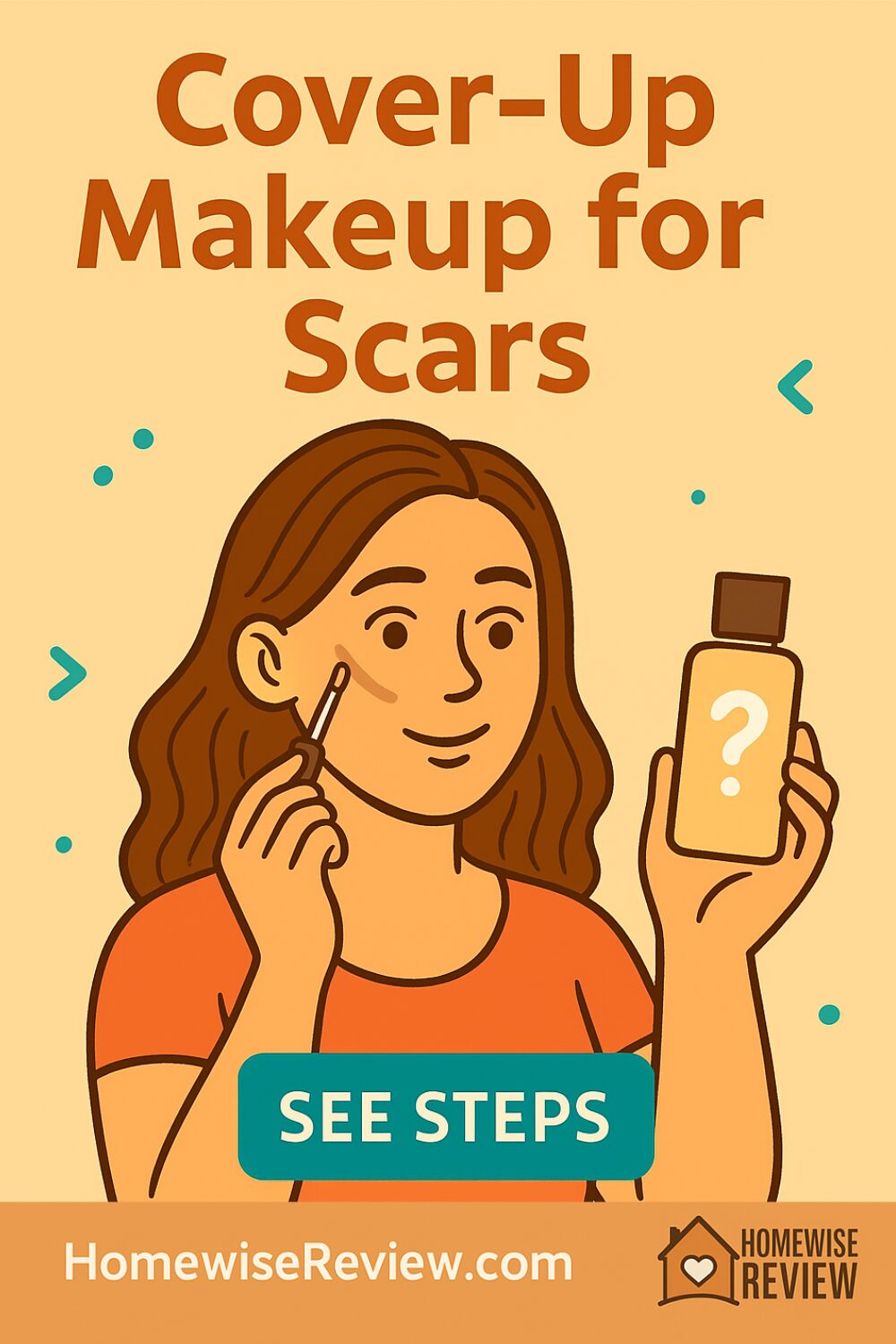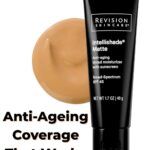
Scars aren’t all the same. Flat/colour scars often just need tone correction and a thin layer of coverage. Indented (atrophic) scars need texture softening + diffusion so they don’t catch the light. Raised/hypertrophic or keloid scars dislike heavy layers—thin, flexible coverage set well is your friend.
What works best: a quick corrector to neutralise colour, a high-pigment yet thin concealer or body cover, and proper setting for transfer resistance.
Quick Picks (tap to see on Amazon)
- Best Face Concealer for Scars: Dermablend Quick-Fix Concealer Stick — high-coverage, thin swipe, flexible dry-down. Rating: 4.7/5
- Best All-Over Face/Body: Dermablend Leg & Body Makeup — buildable liquid that covers surgical/old scars and blends with body moisturiser. Rating: 4.6/5
- Best Corrector (Red/Purple Scars): LA Girl Pro Conceal in Green/Yellow — sheer but effective neutralising without bulk. Rating: 4.5/5
- Best Long-wear Face Foundation: Estée Lauder Double Wear Stay-in-Place — thin layers, 24-hour hold when set. Rating: 4.6/5
- Best Budget Transfer-Proof Powder: Maybelline Fit Me Matte + Poreless Powder — presses down texture and holds base. Rating: 4.4/5
- Best Setting Spray (Face & Body-safe on clothes): Urban Decay All Nighter — locks makeup and reduces rub-off. Rating: 4.6/5
How to Choose (match to scar type)
1) Colour first
- Red/purple scars: dab green corrector first.
- Brown marks (PIH): use peach/peach-orange on medium–deep skin; peach on fair.
- White/silvery scars: skip colour; focus on soft diffusion and a light base so it doesn’t look chalky.
2) Texture plan
- Indented/ice-pick: avoid heavy, dewy bases that pool. Use thin, higher-pigment formulas + blur primer just around the scar.
- Raised/keloid: thick layers highlight edges. Use thin, flexible coverage; pat, don’t rub.
3) Finish & wear
- For face: natural-matte holds shape best.
- For body/clothing contact: look for transfer-resistant and set with powder + setting spray.
4) Shade strategy
- Concealer should match your skin exactly for scars. If choosing between shades, go slightly warmer—cool too light looks grey.
Techniques that make the difference
- Micro-conceal: correct → tiny brush → press concealer only on the scar → feather edges with a clean finger.
- Stipple, don’t swipe: for texture, stipple with a soft sponge so pigment sits over the scar.
- Double set: pinpoint powder with a small brush, then a light overall dusting; finish with setting spray.
- Body blend: mix body foundation with your body lotion on edges so it disappears seamlessly.
- Photographs: avoid high-shine highlighter near textured scars; choose soft-focus, not dewy.
The Winners (deep dives)
1) Dermablend Quick-Fix Concealer Stick — Best for pinpoint face coverage
Performance: High-pigment stick melts on contact for quick dot-conceal; sets down natural-matte and resists migration.
Ease of use: Swipe then press with fingertip or a micro-brush.
Who it’s for: Flat/raised facial scars; post-surgery lines; red marks.
Skip if: Very oily T-zones without powder.
Pros: Tiny amount covers; travel-friendly; works over corrector.
Cons: Can look dry if over-layered.
Rating: 4.7/5
2) Dermablend Leg & Body Makeup — Best for body and larger areas
Performance: Thin liquid that builds from medium to full; dries flexible; water-resistant when set.
Ease of use: Apply in two thin coats, set with powder, then setting spray.
Who it’s for: C-section, knee/elbow, arm or leg scars; uneven body tone.
Skip if: You need true swim-proof (you’ll still want careful setting).
Pros: Large tube; natural skin look; shade range.
Cons: Needs proper set to avoid transfer.
Rating: 4.6/5
3) LA Girl Pro Conceal (Green / Yellow / Peach) — Best budget corrector
Performance: Sheer-to-medium neutralising that removes the need for heavy base.
Ease of use: Paint a thin veil, let it sit 15–20 seconds, then tap concealer on top.
Who it’s for: Red/purple scars (green/yellow), brown marks (peach).
Pros: Squeezy brush tip; inexpensive; blends easily.
Cons: Can separate if layered too wet—allow brief set time.
Rating: 4.5/5
4) Estée Lauder Double Wear Stay-in-Place — Best long-wear foundation for scar areas
Performance: Thin but high-pigment liquid; semi-matte; resists heat/humidity.
Ease of use: Apply sheer layer with sponge; add micro-conceal where needed.
Who it’s for: Mixed areas (discolouration + texture).
Pros: Lasts; shade range; plays well with correctors.
Cons: Can feel dry unless skin is prepped.
Rating: 4.6/5
5) Maybelline Fit Me Matte + Poreless Powder — Best budget setting
Performance: Presses down glow and lightly blurs texture without heaviness.
Ease of use: Press, don’t sweep.
Pros: Affordable; handbag-friendly; lots of shades.
Cons: Not for very dry areas.
Rating: 4.4/5
6) Urban Decay All Nighter Setting Spray — Best lock-in step
Performance: Mist that melts layers together and reduces transfer.
Use: Spray before powder (sandwich) and again after.
Pros: Increases wear; helps body makeup on clothes.
Cons: Light scent.
Rating: 4.6/5
Step-by-Step: Face Scar Cover (5 minutes)
- Prep: cleanse; a tiny bit of moisturiser only where dry.
- Prime (optional): dab a blur primer just around indented scars.
- Correct colour: thin veil of green/peach only where needed.
- Conceal: press Dermablend Quick-Fix over the scar; feather edges.
- Base (if using): sheer layer of Double Wear around the area to unify.
- Set: pinpoint powder on the scar → light dust over the zone.
- Lock: mist with All Nighter.
Body Scar Cover (transfer-resistant)
- Moisturise body 10 minutes before.
- Apply Dermablend Leg & Body in two thin coats; let each dry 60–90 seconds.
- Press with powder; finish with setting spray.
- If dressing, allow 10–15 mins before clothing; avoid tight seams rubbing the area.
Wrap-Up
Great scar cover isn’t about more makeup—it’s about smarter layers: correct colour, place coverage only where needed, then set properly. For fast, reliable results most days, pair LA Girl Pro Conceal (to neutralise) with Dermablend Quick-Fix on the scar, unify with a thin layer of Double Wear, then press powder + All Nighter. Thin, flexible, believable—and it lasts.
We may earn a small referral fee at no extra cost to you.
FAQs
Will makeup make scars worse?
No—provided you remove gently. Use micellar water or a mild gel cleanser; don’t scrub raised scars.
How do I stop coverage sinking into indented scars?
Go thin + targeted. Blur primer just around the scar, then micro-conceal and set.
What about waterproof days (weddings, heat)?
Double set (powder then spray), keep blot papers handy, and avoid thick creamy layers.
Can I cover new scars?
Only after your clinician says the wound is fully healed; choose fragrance-free products at first.
See also
Working on confidence boosters and base that behaves? Start with Best Concealer for Dark Circles for crease-light texture, and Makeup for Dark Circles: Correct, Conceal, Set to refine your technique. If breakouts are part of your story, our Best Foundation for Acne-Prone Skin keeps coverage light yet dependable.




